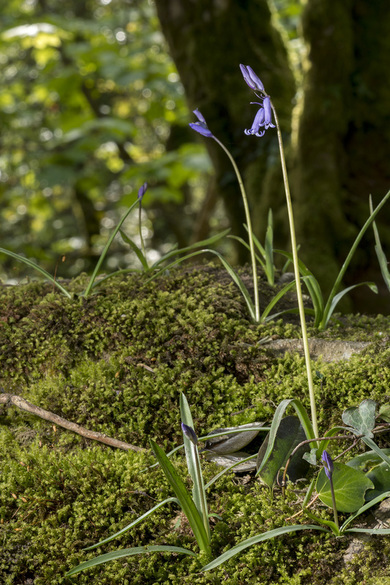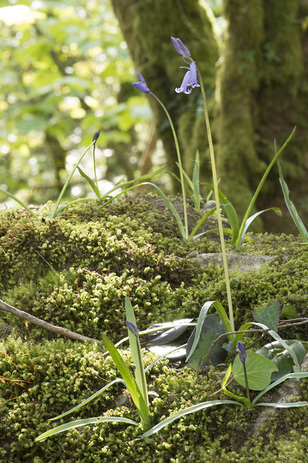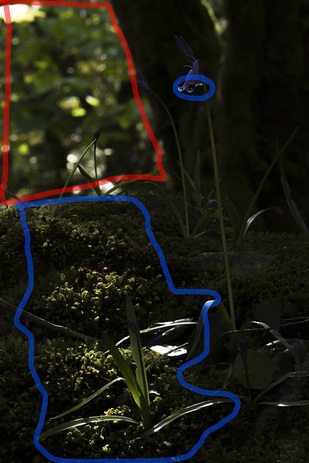
The point of this post is a bit different from the past few. It's no award winning image, but I want to talk about the different aspects of the image and how it was taken...
So, the majority of the Bluebells are out at the reservoir and I walked down there yesterday afternoon to photograph the flowers. I took this image when I saw these three bluebells lined up at different stages of their growth.
Camera Settings:
- Nikon D7100 with 105mm F/2.8 Macro.
- Manfrotto tripod with vanguard ball head, set up roughly a metre from the subject.
- Yongnuo YN-467ii with RF-602 transmitter/receiver.
- Trigger release for the camera.
- F/16 - 1/13th @ ISO-100
- Single flash off-set to the left around 40cm from the subject, with inbuilt reflector to spread the light across the scene.
Lighting:
So the whole point to me writing this blog, is that this wasn't taken how I would usually have photographed it. I started out trying the natural light, you can see two images below which I will talk about now.
So the image below, to the left is the natural light shot, exposed for the bluebell. Now usually I would be okay with this image and in post-production I would save the highlights/lower shadows etc, but instead I chose to play around with the lighting and get it close to the correct exposure in camera. From this first image I could see where the natural light was hitting, but just in case you can't I underexposed by a couple of stops and have increased the highlights/darkened shadows to accentuate how the sun was lighting the scene (image on the right). The result shows the brightest part of the image (red area) and which parts of the immediate surrounding of the subject are lit (blue areas). From seeing this I knew what exposure to use for the background, what power to have my flash at and where to position it.
I held exposed for the leaves in the background to look their best and then chose an aperture which would give a depth of field in which most of the scene was in focus. I then used my flash at full power with it's in built reflector to light the bluebell and surrounding area. The one problem that I ran into was the light from the sun on the moss, along with the flash made it a fair bit too bright. As this was the only problem, I chose to fix this in post.
So, the majority of the Bluebells are out at the reservoir and I walked down there yesterday afternoon to photograph the flowers. I took this image when I saw these three bluebells lined up at different stages of their growth.
Camera Settings:
- Nikon D7100 with 105mm F/2.8 Macro.
- Manfrotto tripod with vanguard ball head, set up roughly a metre from the subject.
- Yongnuo YN-467ii with RF-602 transmitter/receiver.
- Trigger release for the camera.
- F/16 - 1/13th @ ISO-100
- Single flash off-set to the left around 40cm from the subject, with inbuilt reflector to spread the light across the scene.
Lighting:
So the whole point to me writing this blog, is that this wasn't taken how I would usually have photographed it. I started out trying the natural light, you can see two images below which I will talk about now.
So the image below, to the left is the natural light shot, exposed for the bluebell. Now usually I would be okay with this image and in post-production I would save the highlights/lower shadows etc, but instead I chose to play around with the lighting and get it close to the correct exposure in camera. From this first image I could see where the natural light was hitting, but just in case you can't I underexposed by a couple of stops and have increased the highlights/darkened shadows to accentuate how the sun was lighting the scene (image on the right). The result shows the brightest part of the image (red area) and which parts of the immediate surrounding of the subject are lit (blue areas). From seeing this I knew what exposure to use for the background, what power to have my flash at and where to position it.
I held exposed for the leaves in the background to look their best and then chose an aperture which would give a depth of field in which most of the scene was in focus. I then used my flash at full power with it's in built reflector to light the bluebell and surrounding area. The one problem that I ran into was the light from the sun on the moss, along with the flash made it a fair bit too bright. As this was the only problem, I chose to fix this in post.
I hope you all liked this post and maybe it gave you a little insight into the lighting that you can use for flower photography. At university and from other blogs I have read, I am often told to use reflectors and for me, when I was out and didn't have any reflectors, I wouldn't get the photograph I wanted. So, now I carry a flash with me instead of reflectors, maybe you spend a little more on batteries but it's much more flexible and I don't think I could've done this shot with a reflector(s).
Thanks for reading, any likes, shares and comments are really appreciated!
You can follow my work closer on Facebook by clicking on this link --> AlexGreenePhotography
Thanks for reading, any likes, shares and comments are really appreciated!
You can follow my work closer on Facebook by clicking on this link --> AlexGreenePhotography


